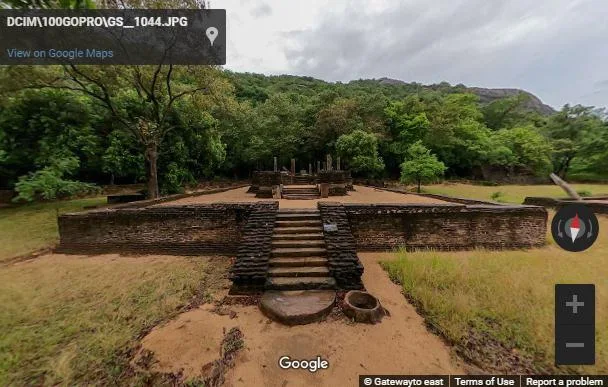
|
Photo credit: Gatewayto east, Google Street View |
Namal Pokuna Archaeological Site (Sinhala: නාමල් පොකුණ පබ්බත විහාරය) is a ruined Buddhist monastery complex situated near the famous Dimbulagala Viharaya in Polonnaruwa District, Sri Lanka.
History
Traditional Beliefs
The history of this site is associated with Kuveni, the queen of King Vijaya (543-505 B.C.) who is traditionally considered the first ruler of Sri Lanka. It is said that the Yaksa tribe (to which Kuveni belongs) was ruling the country from their citadel situated in the Dimbulagala mountain range when Vijaya assumed power in the country. As mentioned in the chronicle Mahavamsa, Prince Pandukabhaya (reigned 474-367 B.C.) had taken refuge at this place for four years.
Inscriptions & Other Structures
Several Early Brahmi Inscriptions have been found in the rock caves scattered around the Namal Pokuna monastery (Paranavitana, 1970). As revealed by them, this site was a Buddhist monastery site since the 3rd century B.C.
Period: 3rd century B.C.-1st century A.D. Script: Early Brahmi Language: Old Sinhala
Transcript: Asha Shumanaha lene shagasha
Translation: The cave of the Venerable Sumana, [is given] to the Sangha.
Citation: Paranavitana, 1970. p.22.
Some constructions of this monastery belong to the first phase of the Anuradhapura Period while the others have architectural features of the Polonnaruwa Period (Wikramagamage, 2004). It is said that Sundara, the queen of King Parakramabahu the Great (1153-1186 A.D.) built 500 caves, ponds, Stupas, and Buddha images for the Buddhist monks living here.
The Pabbata Vihara Monastery
The ruins of a Pabbata Vihara-type monastery are found in the Namal Pokuna premises (Wikramagamage, 2004). It includes the ruins of a Stupa, Bodhighara (Bodhi-tree shrine), Pohoyage (Chapter House), Patimaghara (image house), and other structures such as a pond and a stone bridge (Wikramagamage, 2004). The majority of ruins are enclosed by a wall (97.6 m long and 83 m wide) with four cardinal entrances (Wikramagamage, 2004). The wall is 4 ft. high and has an average width of 3 ft. (Wikramagamage, 2004).
Stupa
The Stupa is located to the south of the main entrance to this monastery. Probably belonging to the first phase of the Anuradhapura Period (before the 7th century), it is considered the oldest monument found in the Namal Pokuna monastery (Wikramagamage, 2004). It is a brick-built monument shaded in ancient times by stone umbrellas [(Chatra stones) Wikramagamage, 2004]. The present Stupa is 4.5 m in height and has a circumference of about 36.5 m (Wikramagamage, 2004).
Pohoyage
The Pohoyage building is 21 m in length and 14 m in width (Wikramagamage, 2004). A flight of steps provide access to it. Inside the building are 11 standing pillars and in ancient times, it had a roof covered with clay tiles (Wikramagamage, 2004).
Patimaghara
The ruined Patimaghra or the image house of this monastery is 15.2 m long and 11 m wide (Wikramagamage, 2004). A Sandakada Pahana (moonstone) without carvings is found at the entrance of it. A 2.55 m tall broken image of the Buddha is found inside the image house (Wikramagamage, 2004). Stylistically, it belongs to the Polonnaruwa Period (Wikramagamage, 2004).
Related Posts
Read Also
References
Books
1) Paranavitana, S., 1970. Inscription of Ceylon (Vol. I). Department of Archaeology Ceylon. pp.22-23.
2) Wikramagamage, C., 2004. Heritage of Rajarata: Major natural, cultural and historic sites. Colombo. Central Bank of Sri Lanka. pp.253-254.

